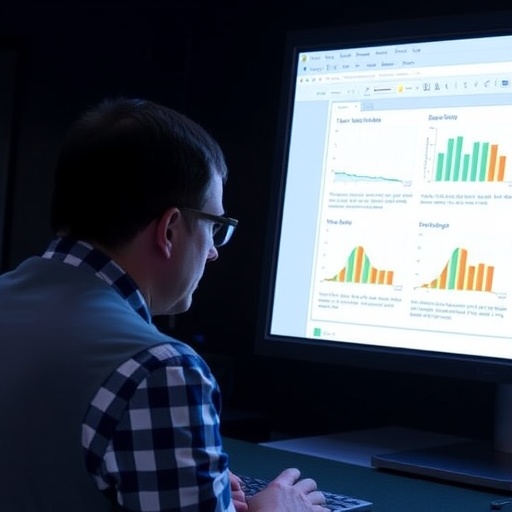In the relentless pursuit to advance medical diagnostics, a groundbreaking study introduces WDRIV-Net, a sophisticated weighted ensemble transfer learning model designed to revolutionize the automatic stratification of lumbar intervertebral disc conditions. This innovative approach addresses a crucial challenge in medical imaging—the precise classification of lumbar disc degeneration types, which range from singular manifestations like herniation, bulge, or prolapse to complex comorbid presentations involving simultaneous degenerative conditions.
Lumbar intervertebral disc degeneration is a predominant contributor to neurological impairments and chronic physical disabilities worldwide. Accurate and early identification of specific degeneration types is paramount for tailoring clinical interventions and improving patient outcomes. Traditional diagnostic techniques rely heavily on manual interpretation of magnetic resonance imaging (MRI) scans, which are time-consuming and prone to inter-observer variability. Against this backdrop, the advent of advanced machine learning algorithms, and particularly ensemble transfer learning models, heralds a transformative potential.
WDRIV-Net’s architecture embodies the strategic ensembling of four powerful, pre-trained convolutional neural networks—Densenet169, ResNet101, InceptionV3, and VGG19—each bringing distinct feature extraction capabilities and architectural nuances. By integrating these models within a weighted transfer learning framework, WDRIV-Net capitalizes on their complementary strengths, yielding enhanced generalization and robustness. This fusion engenders a synergistic effect that surpasses the limitations observed in individual models and conventional ensemble approaches.
The empirical foundation of this study rests on a diverse dataset comprising lumbar MRI images collated from several clinical hospitals across China. This extensive, multi-center data pool ensures that the model training encapsulates a wide array of patient demographics and imaging variations, bolstering the reliability and applicability of WDRIV-Net in real-world clinical scenarios. The rigorous validation phase showcased WDRIV-Net achieving an unprecedented classification accuracy of 96.25%, setting a new benchmark in the stratification of lumbar intervertebral disc degeneration.
Comparative analyses reveal that WDRIV-Net substantially outperforms standalone expert models such as ResNet101 (87.5% accuracy), DenseNet169 (82.5%), VGG19 (88.75%), and InceptionV3 (93.75%). Furthermore, when evaluated against existing state-of-the-art ensemble deep learning techniques, WDRIV-Net delivered a notable uplift in performance metrics. Such superiority is not confined to accuracy alone; the model also demonstrated a significant increase in the area under the receiver operating characteristic curve (AUC), a critical measure of diagnostic specificity and sensitivity.
One of the pivotal strengths of WDRIV-Net lies in its capacity to discern subtle pathological features characteristic of different disc degeneration types. By leveraging deep hierarchical feature representations learned through transfer learning, the model adeptly identifies minute variations across MRI slices that might elude conventional methods. This nuanced detection facilitates differentiation between single-type degenerations and complex comorbid conditions—a capability vital for personalized treatment planning.
From a methodological perspective, the ensemble’s weighting scheme was meticulously optimized to balance contributions from each constituent model, thereby reducing model bias and variance. This calibration ensures that the combined prediction reflects the most reliable consensus, enhancing interpretability and confidence in clinical deployment. Additionally, the transfer learning strategy significantly reduces the need for massive labeled datasets by leveraging knowledge from pre-trained networks on large-scale image repositories.
The clinical implications of deploying WDRIV-Net are profound. Early and accurate stratification of lumbar disc pathology can expedite decision-making processes, guide therapeutic strategies, and mitigate progression toward severe disability. The system’s robustness also promises scalability across heterogeneous clinical environments, supporting telemedicine applications where expert radiological resources might be scarce.
Moreover, the study underscores the potential for integrating WDRIV-Net within existing radiological workflows. Its rapid inference capabilities allow real-time screening and prioritization, enabling clinicians to focus their expertise on ambiguous or complex cases. Such intelligent triage can significantly improve resource allocation and patient throughput in busy clinical settings.
Looking forward, the research paves the way for further enhancements, including the incorporation of multi-modal imaging data and longitudinal patient records to predict disease progression trajectories. Integrating explainability modules could augment transparency, fostering trust among medical practitioners by elucidating decision rationales behind model predictions.
In summary, WDRIV-Net epitomizes a leap forward in medical AI, harmonizing state-of-the-art deep learning architectures with clinically driven objectives. This weighted ensemble transfer learning framework not only elevates diagnostic precision but also embodies an adaptable platform poised to transform lumbar intervertebral disc disease management. As AI continues to permeate healthcare, such innovations promise to bridge gaps between technology and patient-centered care, heralding a new era in musculoskeletal disorder diagnosis.
—
Subject of Research: Weighted ensemble transfer learning for automatic stratification of lumbar intervertebral disc degeneration types including bulge, prolapse, and herniation.
Article Title: WDRIV-Net: a weighted ensemble transfer learning to improve automatic type stratification of lumbar intervertebral disc bulge, prolapse, and herniation.
Article References:
Nakamoto, I., Chen, H., Wang, R. et al. WDRIV-Net: a weighted ensemble transfer learning to improve automatic type stratification of lumbar intervertebral disc bulge, prolapse, and herniation. BioMed Eng OnLine 24, 11 (2025). https://doi.org/10.1186/s12938-025-01341-4
Image Credits: Scienmag.com
DOI: https://doi.org/10.1186/s12938-025-01341-4




